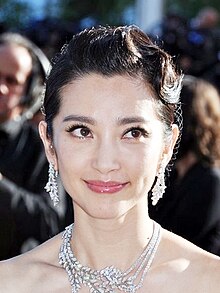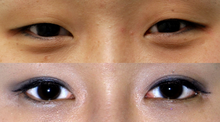Chinese ideals of female beauty
A 2018 survey conducted by the Great British Academy of Aesthetic Medicine concluded that Chinese beauty culture prioritizes an oval face shape, pointed, narrow chin, plump lips, well defined Cupid's bows, and obtuse jaw angle.
[3][4] Similarly, pale, ivory skin, and a slim body figure have historical implications as being a physical representation of wealth and affluence.
Historically, an oval face, willow leaf eyebrows, long thin eyes, small lips, and a slim, fragile-looking body were preferred during the Tang dynasty.
An article published in the widely circulated journal Dushu uses an earlier nativist satire to argue that women themselves voluntarily desired the beauty of small feet (footbinding) into the first decades of the twentieth century, despite the elite, male-dominated discourse of liberation and equality that assailed the practice, claiming, "during the long historical period when foot binding became common women's way of life, foot binding was just considered the most natural physical behavior for girls.
"[10][11] In Chinese culture, there is a significant emphasis placed on the appearance and physical allure of women, which is apparent in both business and social settings.
John Osburg, Director of Anthropology at the University of Rochester in his book, Anxious Wealth, explores the gender relations in Post Mao China, documenting the well-known disparity that exists between men and women.
A theme of his work is that the objectification of women as a commonplace in Chinese culture creates the gender inequalities that are still prevalent today.
This is largely due to the fact that business networking requires entering spaces (such as nightclubs and saunas) and participating in activities (drinking, gambling, and sex consumption) that are not viewed as appropriate for "proper" women....these networks constitute a key component of business...the bulk of the relationships of these networks are forged and maintained through ritualized leisure-experiences of shared pleasures catering to the desires and enjoyments of elite men, including karaoke clubs, saunas, nightclubs, high-end restaurants, and teahouses.
[12] On a woman, long, shining black hair is regarded as exceptionally beautiful, particularly when its growth is strong and luxuriant.
[5] In the Spring and Autumn period (722–481 BC), Emperor Chu desired a slim waist; women in his harem often starved themselves to death in order to capture his attention.
The Chinese idiom huanfei yanshou (環肥燕瘦, literally "plump Huan, slender Fei") is used to refer to the range of types of beauties.
Yang Yuhuan, the "plump Huan", is estimated by unofficial records to have been 1.65 meters tall and weighed 69 kilograms.
Modern Chinese people have long considered the ideal woman's body to be relatively tall, slim, and curvaceous.



